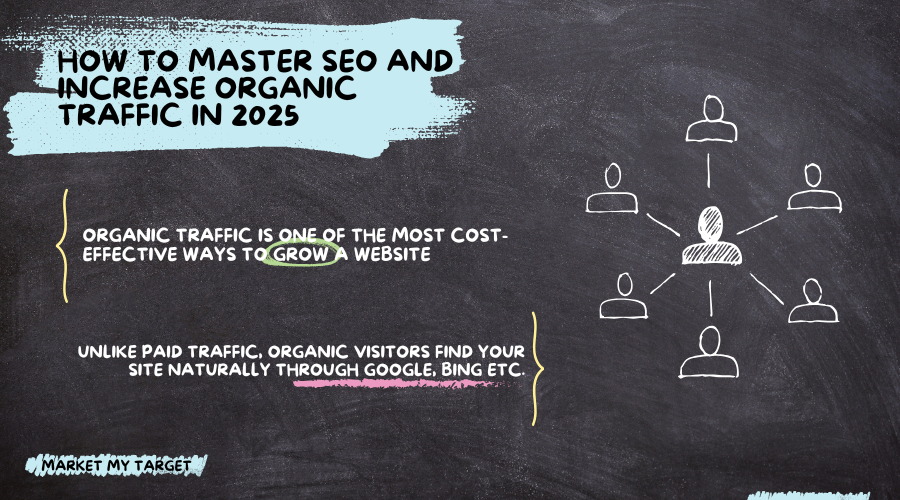How to Master SEO and Increase Organic Traffic in 2025
- Shivani Singhania
- Mar 12
- 4 min read
Search Engine Optimization (SEO) is no longer just a marketing tactic—it’s a necessity for online success. With Google’s continuous updates and the rise of AI-driven search, businesses need to stay ahead of the curve to maintain visibility. Organic traffic remains one of the most cost-effective ways to grow a website, as it brings in high-intent visitors without requiring direct ad spend.
Table of Contents

What Is Organic Traffic?
Organic traffic refers to the visitors who land on your website through unpaid search engine results. Unlike paid traffic, organic visitors find your site naturally through platforms like Google, Bing, and DuckDuckGo.
Why is organic traffic important?
Cost-Effective – No direct advertising costs.
Higher Trust & Credibility – Users trust organic results more than paid ads.
Long-Term Growth – SEO efforts compound over time, leading to sustained traffic increases.
How to Measure Your Organic Traffic
Before optimizing for organic growth, you need to track and analyze your current traffic levels. Here are two powerful tools to measure SEO performance:
Google Analytics (GA4)
GA4 helps track organic search performance, user behavior, and conversion rates. To find your organic traffic data:
Log in to Google Analytics.
Navigate to Acquisition > Traffic Acquisition.
Filter by Organic Search to see your traffic trends.
Google Search Console
Google Search Console (GSC) provides insights into search visibility, keyword rankings, and site performance. Key metrics include:
Clicks – How often users click your site from search results.
Impressions – How often your pages appear in Google.
Average Position – Your page's ranking in search results.
Click-Through Rate (CTR) – The percentage of impressions that resulted in clicks.
12 Powerful Strategies to Increase Organic Traffic
Ready to boost your organic search rankings? Follow these expert-backed strategies:
Master Keyword Research
Keyword research is the foundation of any SEO strategy. Here’s how to do it effectively:
Use Google Keyword Planner, Ahrefs, or SEMrush to identify high-traffic, low-competition keywords.
Focus on long-tail keywords (e.g., “best SEO tools for startups”) for higher intent and less competition.
Optimize for search intent (informational, transactional, navigational).
Optimize On-Page SEO
On-page SEO ensures that your content is structured for search engines. Key elements include:
Optimized title tags & meta descriptions
Proper use of header tags (H1, H2, H3)
Image alt text for accessibility & SEO
Internal & external links for content authority
Write Engaging and Click-Worthy Titles
A compelling headline boosts CTR and improves rankings. Best practices:
Use power words & numbers (e.g., "10 Expert SEO Tips for 2025").
Keep it under 60 characters to avoid truncation.
Use a headline analyzer to optimize wording.
Create High-Quality, Helpful Content
Google’s Helpful Content Update prioritizes value-driven, user-first content. To rank higher: Answer search queries thoroughly.
Use data, stats, and case studies for credibility.
Break content into sections using bullet points and lists.
Optimize for AI Overviews & Featured Snippets
AI-driven search is reshaping Google’s ranking landscape. Increase chances of being featured by:
Using structured headings & bullet points.
Adding schema markup for better search visibility.
Providing direct, concise answers to common questions.
Run an SEO Audit
An SEO audit identifies errors that may be hindering rankings.
🛠 Use tools like AIOSEO, Screaming Frog, or Semrush to check for:
Broken links
Duplicate content
Missing meta tags
Slow-loading pages
Leverage Google Search Console for Insights
Monitor technical SEO issues, indexing status, and keyword performance.
Regularly submit updated XML sitemaps.
Check for Core Web Vitals performance (page speed & mobile usability).
Build a Strong Internal Linking Strategy
🔗 Internal links improve SEO by:
Distributing "link equity" across pages.
Enhancing user navigation & engagement.
Helping search engines understand content hierarchy.
Boost Authority with High-Quality Backlinks
Backlinks remain one of the strongest ranking factors.
Guest posting on authoritative sites.
Broken link building (finding and replacing dead links).
Creating linkable assets (guides, case studies, infographics).
Refresh and Update Old Content
Google prioritizes fresh, updated content.
📝 Steps to update content:
Re-optimize for trending keywords.
Add new statistics & research data.
Improve readability & update formatting.
Improve Website Speed & Core Web Vitals
Slow websites hurt rankings & increase bounce rates. Optimize by:
Using Google PageSpeed Insights to analyze performance.
Compressing images & enabling browser caching.
Using a Content Delivery Network (CDN) for faster global access.
Optimize for Mobile-First Indexing
Google now prioritizes mobile versions of websites for ranking.
Use responsive web design.
Ensure touch-friendly navigation.
Optimize mobile loading speed for seamless UX.
Measuring SEO Success: Key Metrics to Track

⚠️ Essential SEO Metrics:
Organic Traffic (Google Analytics)
Keyword Rankings (SEMrush, Ahrefs)
Backlink Profile (Moz, Ahrefs)
Bounce Rate & Dwell Time (Google Analytics)
Frequently Asked Questions to Increase Organic Traffic
Q. How long does it take to see SEO results?
A. Typically 3-6 months, but it depends on competition & strategy.
Q. Do backlinks still matter?
A. Yes! High-quality backlinks improve domain authority & rankings.
Q. What’s the best free SEO tool?
A. Google Search Console & Google Analytics provide core SEO insights.
Final Thoughts: Future-Proofing Your SEO Strategy
SEO is constantly evolving, and staying ahead requires continuous learning and adaptation. Implement these 12 expert strategies to build sustainable organic traffic in 2025 and beyond.




